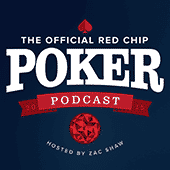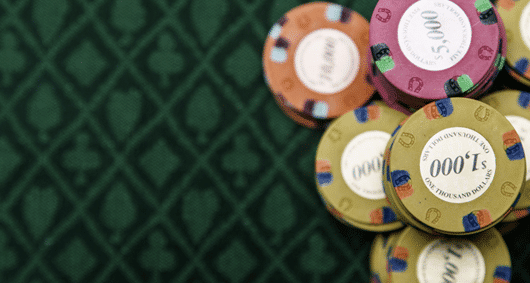High-roller and in-demand coach Matt Berkey is back on the podcast, and this episode starts with an in-depth discussion on range merging. What is a merged range, and how can we use it to balance our play and keep our opponents guessing? Berkey gives his advice on this topic, as well as a breakdown of his overall thought process while playing a hand. Take notes, because Berkey is dropping solid gold insights into the mind of a top-level pro.

Range Merging 101
The group of hands that you’re willing to play is a range. This is the start and finish — from top to bottom — list of hands that you’re willing to play. There are boundaries. At the top is boundary one, at the bottom is boundary two. We call these boundaries poles.
In order to describe a merged range, we must first describe a poled range. This is the top of your range combined with the bottom of your range. A merged range is the entire middling portion. If we strip the boundaries away we are left with what effectively is a merged range. The problem is if you played only that range, you’d be too weak because you’re stripping away the best hands. Often when Berkey refers to a merged 3-bet range, he’s talking more about our all-encompassing 3-bet range, including the poles and the middle. We still want to be able to gain maximum value for playing this merged range. Otherwise our 3-bet frequency goes down, which we don’t want.
APPLYING MERGED RANGE
Range merging is something that everyone is doing already, but understanding it is the key. When you look down at KQ suited, and you decide this hand is a 3-bet this time, it’s a merge. It’s important to understand what dynamics causes you to choose this as a value hand vs. your regular value hands and your bluffs. KQ is too good to get blown off by a 4-bet, it’s not a good hand to bluff.
One of the things we want to look at is stack size and SPR. Looking at this, we understand where the leverage point is. If your stack is shallow in a cash game — for example, 50BB — and we face a 3-bet, we have to commit to getting it all in, or fold. If we’re pushed into that corner, we should choose a polarized range. It contains value hands, and then hands like A4 suited we can bluff with because of the ace blocker. When we get shoved on, we can fold to the 3-bet. If we have a value hand like AK suited, we want all the money in there.
Paying attention to those dynamics and understanding where that leverage shift will take place is key. Much deeper at 100 to 150 BB, we have more playability with KQ vs. a 3-bet. Often they will just call the 4-bet or fold, but when they do 4-bet, we have options to fold, call, or even 5-bet.
Nits take hands that are too strong and turn them into bluffs. They back into bluffs with hands like AQ or 99 some of the time. They might not mean to bluff with TT or JJ. They don’t construct a poled range, they use a value-heavy range. They don’t understand what the bottom portion is supposed to do. If you’re folding AQ because you know your opponent has AK, you’re sacrificing 30% equity. Berkey says he’d rather sacrifice A5 suited. Even when he hits a 5 or an A he doesn’t feel great. But if AQ hits a queen, he’s good. And if an ace hits, only the AK is better.

Affinity Hands
People have an affinity for certain hands. Berkey uses KQ suited as an example of a hand he has an affinity for. It’s a very powerful hand that most people discredit. Pocket 9s and pocket tens come to mind too. They’re hands that are often beaten when they face a lot of aggression, but they’re hands that are too good to fold preflop in most circumstances.
Berkey focuses on what the best line of attack is. When you get to the ABC guys, very few people are constructing a bluff range, they’re falling into one. They often adjust in fishy ways, like calling all 3-bets, or getting too aggressive by 4-betting any suited ace or suited connector.
Even good, accomplished players who have been playing for a long time don’t think about construction. Berkey’s a fan of blowing up the rules, but he says you need to know the rules before you break them.
Berkey says off-table study in software is a slippery slope, because it can be a crutch if used incorrectly. He still uses PokerStove, one of the first poker strategy applications to be released.
He is more a fan of understanding the underlying concepts behind the work the software does.
“Just doing the math is not enough if your assertion is wrong,” he says
We’re dealing in fractions of a blind in most instances when we analyze spots. Just adding a couple of hands to your opponent’s range that he doesn’t have will throw the math of. Since there is no such thing as perfect poker, we need the be very careful about the information going into the software.
Often Berkey finds that the lines he comes up with on his own are incredibly close to what the solver suggests. Berkey has a computer science background, he understands how to truncate and expand ranges based on the player he’s up against. He has a good feel for how people are going to adjust. That in turn allows him to manipulate his line work to what he thinks is optimal.
GTO AND EXPLOITATIVE PLAY
Berkey sees GTO and exploitative play as one in the same. He feels everyone got caught up in the hoopla that poker was going to be solved. They wanted to be the first one to get there. Because of that, GTO caught on like wildfire. Everyone loved the idea of following a chart to beat the game. It’s just not possible. The layers of the game are goo deep too complex.
Real exploitative play is GTO in action. It’s the human application of GTO. And Berkey says it makes more sense for multiway pots. Nash Equilibrium doesn’t exist except for heads up scenarios. Very few of us play heads up. Yes, most pots go heads up, but there’s a lot worth considering that led up to that point. The pot didn’t start heads up and things had to happen for it to go heads up. That’s going to skew the calculations. We don’t have the computing power or mind power to truly play GTO.
There are a lot of flaws in the application of GTO, but it’s a novel idea. Berkey says it’s a buzzword. Theoretically speaking, there’s a way to play optimally in any game. We may never get there, but it’s a useful way to look at the game. Essentially, playing a GTO style is really just advanced bluff catching. The best GTO players out there are the best defensive players in the game. That means they’re bluff catching better than the rest. The exploitative players are still the offensive masters.
THOUGHT PROCESS
Berkey’s breakthrough in developing a poker thought process was to become very intimate with postflop play as quickly as possible. He struggled a lot through PLO to get a feel for the grouping of board textures. Once you have a good intuition about boards — is it good, neutral or bad, is it dynamic or static — you know when you’re going to continue post-flop. That’s the off-table work.
Becoming very familiar with your own ranges is critical. Your opponents’ ranges will never be that different from you. You can project your own ranges on to your opponents. Once you have constructed your own ranges and made them intuitive, you don’t have to waste mental energy deducing what your opponents could possibly be playing.
When you can remove the fear factor, the fight or flight notion that is in us all when we’re gambling on uncertain outcomes then you can really put a heightened focus on the mechanics that matter. First and foremost, focus on stack sizes. The easiest way we can influence others in this game is through bet sizing. The way to understand bet sizing is through understanding pot construction. Pot construction is a byproduct of stack sizing. Understanding where the leverage point is — when you get to 2 SPR or below — is critical to making a post-flop plan.
FIND BERKEY
Berkey on Twitter, Instagram and Facebook
Solve for Why Academy
Solve for Why Academy Twitch streaming
